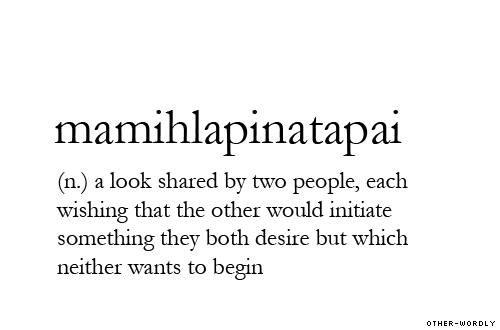
Derived from the Yaghan language of Tierra del Fuego, listed in The Guinness Book of World Records as the "most succinct word", and is considered[who?] one of the hardest words to translate.
A slightly different interpretation of the meaning also exists: "It is that look across the table when two people are sharing an unspoken but private moment. When each knows the other understands and is in agreement with what is being expressed. An expressive and meaningful silence."[2] It is also cited in books and articles on game theory associated with the volunteer's dilemma.
The word consists of the reflexive/passive prefix ma- (mam- before a vowel), the root ihlapi (pronounced [iɬapi]), which means to be at a loss as what to do next, the stative suffix -n, an achievement suffix -ata, and the dual suffix -apai, which in composition with the reflexive mam- has a reciprocal sense.
Yagán (originally Yahgan, but also now spelled Yaghan, Jagan, Iakan), also known as Yámana and Háusi Kúta, is one of the indigenous languages of Tierra del Fuego, spoken by the Yagán people. It is regarded as a language isolate, although some linguists have attempted to relate it to Kawésqar and Chon.
Along with other Fuegian languages, it was among the first South American languages to be recorded by European explorers and missionaries[citation needed]. Yahgan was also spoken briefly on Keppel Island in the Falkland Islands at a missionary settlement.
Tierra del Fuego (pron.: /tiːˈɛərə dɛl ˈfweɪɡoʊ/, Spanish: [ˈtjera ðel ˈfweɣo]; Spanish for "Fireland" or "Land of Fire") is an archipelago off the southernmost tip of the South American mainland, across the Strait of Magellan. The archipelago consists of a main island Isla Grande de Tierra del Fuego divided between Chile and Argentina with an area of 48,100 km2 (18,572 sq mi), and a group of many islands including Cape Horn and Diego Ramírez Islands. While initially discovered by Ferdinand Magellan's expedition in 1520, it was not settled by people of European descent until the second half of the 19th century at the height of the sheep farming and gold rush booms. Today, petroleum extraction dominates economic activity in the north of Tierra del Fuego, while tourism, manufacturing and Antarctic logistics are important in the south.
(Via: Wikipedia)




1 comment:
Trained professionals benefit the methods to produce rubber.
The city has population of around 6 million and it has strong connection with
NRG's and NRI's.
Look at my website; cresus-Bibliotekarz.pl
Post a Comment